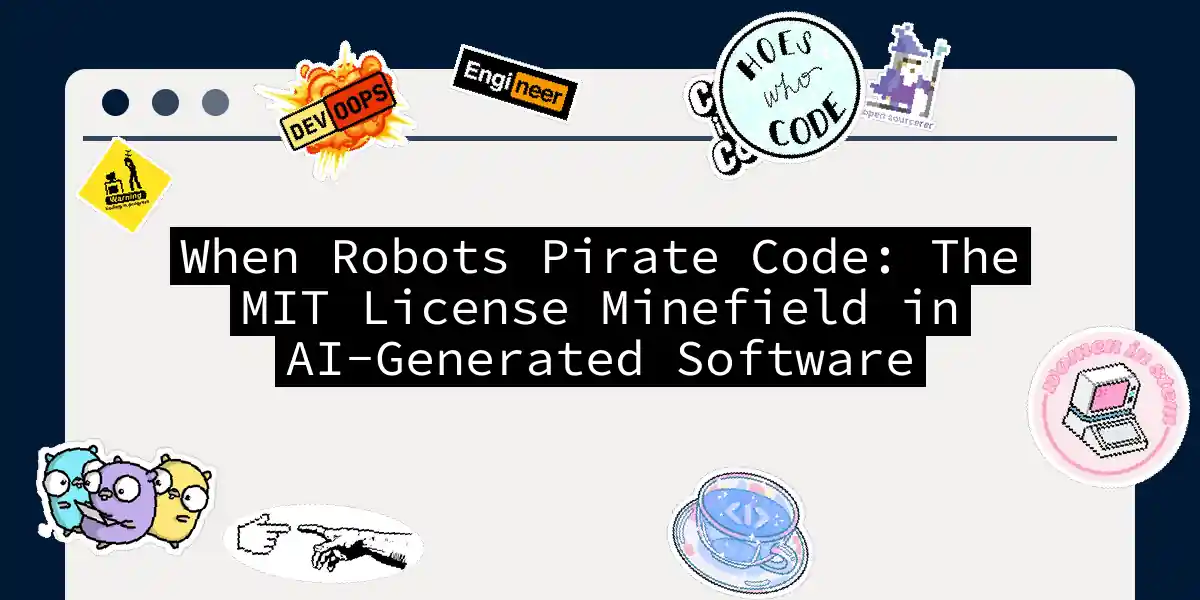Picture this: You’ve just generated a beautiful piece of Python code using the latest AI assistant. It works perfectly, passes all tests, and even has better documentation than your last three team projects. You proudly slap an MIT license on it because “that’s what all the cool open-source kids use.” Congratulations - you might have just become a software pirate. YARRR!
The MIT License: A Brief Refresher (With 50% More Pirate Metaphors)
The MIT License is like the Switzerland of software licenses - neutral, permissive, and everyone thinks they understand it until they actually read the text. At its core, it grants permission to:
# Here's what you're really agreeing to:
print("Do whatever you want with this code, but:")
print("1. Keep this license text")
print("2. Don't sue me if it breaks")
print("3. Bonus points if you send rum") # Not legally binding
But when AI enters the picture, our simple pirate agreement becomes more complex than a Dockerfile with 287 layers.
The Code Generation Paradox
Modern AI coding assistants are like overeager interns who’ve memorized Stack Overflow but failed their ethics class. Consider this common scenario:
# Generate authentication middleware
$ ai-codegen --prompt "JWT verification for Express.js" --license MIT
The output might look perfect, but did the model:
- Paraphrase MIT-licensed code from GitHub?
- Mix in GPL snippets from old forum posts?
- Invent something novel that’s now contaminated? We’ve created a licensing Schrödinger’s cat - until you audit every line, the code exists in a superposition of compliant and infringing states.
Three Ethical Pitfalls Worse Than Forgetting to git pull
1. The Attribution Abyss
AI models don’t cite sources like anxious grad students. That elegant sorting algorithm might be verbatim from an MIT-licensed project… or a proprietary codebase. I once found an AI-generated “MIT” function that turned out to be contaminated with Windows 95 system code. The ghosts of Gates past came knocking!
2. License Incompatibility Roulette
Imagine this dependency chain from hell:
Your MIT Code -> AI-Generated BSD Snippet -> GPL Helper -> Proprietary Deep Magic
You’ve now created a license singularity that could collapse your project into a black hole of litigation.
3. The Contributing Conundrum
When you accept AI-generated PRs without proper checks:
# In your project's CONTRIBUTORS.md
- Alice (Human)
- Bob (Human)
- DeepCoder-9000 (Probable IP Thief)
Practical Defense Strategies (Tested on Real Developers)
Step 1: The License Sniffer
Create a pre-commit hook that checks for license contamination:
#!/bin/bash
# license_sniffer.sh
for file in $(git diff --cached --name-only); do
if grep -qE 'GPL|Apache|BSD' $file; then
echo "🚨 License contamination detected in $file!"
echo " AI-generated code may contain incompatible licenses"
exit 1
fi
done
Step 2: The Attribution Amplifier
Add this to your CI pipeline:
# .github/workflows/license-check.yml
name: License Audit
on: [pull_request]
jobs:
license-check:
runs-on: ubuntu-latest
steps:
- uses: actions/checkout@v4
- name: Scan for license fingerprints
run: |
grep -rnw '.' -e 'Copyright' --exclude-dir=node_modules
echo "🧐 Remember: No attribution = Ticking legal time bomb!"
Step 3: The Human Firewall
Implement a 3-step code review process for AI-generated code:
- License Lasso: Run
licensebat --generate bill_of_materials.txt - Lineage Check: Compare against training data sources (where possible)
- Paranoia Session: “Why does this code look sus?” beer-fueled team review
The Organizational Policy Jenga Game
For teams larger than two developers and a office dog:
| Policy Layer | What It Should Cover | Reality Check |
|---|---|---|
| Code Generation | Approved tools, output validation | “No, GitHub Copilot isn’t a lawyer” |
| License Management | Automated scanning, contamination thresholds | “GPL code has cooties” |
| Contributor Flow | AI disclosure requirements | “Robot code = human liability” |
| Audit Trail | Code provenance documentation | “Cover your ASCII” |
The Ultimate Question: Who Owns the Code?
In 2025, we’re still stuck in a legal limbo worthy of Kafka. Current landscape:
- US Copyright Office: “AI-generated code is like a monkey selfie - no copyright”
- EU AI Act: “You must document training data sources… lol good luck with that”
- MIT Legal Dept: * nervous sweating *
Join the Conversation
I’ll leave you with three discussion prompts that ignite more passion than vim vs emacs debates:
- Should AI-generated code come with a “nutrition label” showing license ingredients?
- If an AI model was trained exclusively on MIT-licensed code, is its output automatically MIT?
- How many lawyers does it take to change a lightbulb in an AI-generated codebase? Drop your thoughts in the comments below. Bonus points if your argument references both Kant and the Linux kernel development process. Disclaimer: This article does not constitute legal advice. Any resemblance to actual lawyers, living, dead, or robotic, is purely coincidental.
